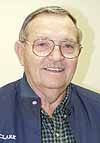| Clark Warren |
The Korean War was called a “Police action” by the politicians, but for the soldiers that were in it, it was a full fledged war. In June of 1950 the North Korean Army crossed the 38th parallel and invaded South Korea. America and the United Nations quickly responded by sending forces to drive back the Koreans which they did. Sixteen nations supplied troops to the fight, but over 90 percent of the men that fought were Americans.
In time the United Nations troops drove the Koreans almost to their border with China, but the Chinese, obviously feeling threatened, attacked and with their huge advantage in numbers of troops were able to push the U.N. troops back to the 38th parallel where an uneasy tension holds to this day. The U.S. still has thousands of troops in South Korea today, with the possibility of another war just a few gunshots away.
Clark Warren, who was born on the banks of the Ohio River in southeastern Ohio was one of the men that fought in the Korean War. Warren, who has called Carbon County his home for many years, joined the Navy in 1948 and immediately knew he wanted to be in the Naval Air Force.
He went to boot camp at the Great Lakes Naval Training Facility and then was sent to Memphis, Tenn. for airman’s and ordinance school.
In 1949 he was sent to the west coast and attended gunnery school in San Diego. He was then transferred to a Navy patrol bomb squad on North Island in San Diego.
He was placed on an airplane few today have every seen, a Navy PBM, a metal hulled seaplane. On that plane, which carried a crew of up to 12 men, he was the rear tail gunner.
These planes were designed as basically a flying boat and residence all in one. They could land anywhere there was enough water and the plane had four bunks and a kitchen in it.
Two months after he joined the unit, the North Koreans crossed the 38th parallel and within 24 hours his team was organized to go to Korea. The first leg of the journey in the plane was a 17 hour flight to Ford Island in Hawaii. Eventually they ended up in Japan, after numerous fuel stops they finally arrived in Japan four days later.
There missions once the reached Korea were many. The served as patrol aircraft watching for Chinese junks which were used to covertly move supplies.
“We would fly over and from a distance sometimes you could see them lowering their North Korean or Chinese flag, and putting up a South Korean flag,” says Warren. “Then we would fly over and they would wave at us, but off in the distance we could see them putting their real flag back up, so they would be shot at by their own people. We would then go back and sink them.”
One time while flying a mission the plane was struck by flak from an anti-aircraft gun on the ground. It damaged the belly of the plane and since the aircraft could not land on dry land when they landed it started to fill up with water.
“A bunch of us dressed down to our skivies and jumped overboard and began stuffing mattresses into the holes to keep it from leaking,” he says.
At one point it was considered by the admiralty that the planes in the PBM units and a British air wing of seaplanes fly and land on a reservoir to ‘rescue troops that were cut off. This would have been extremely dangers due to ground fire and the slow moving aircraft. However, when the leadership discovered the reservoir was frozen over the plan was abandoned.
The plane was also used for some intelligence work using cameras, but that didn’t happen too much. But the jet age was catching up with the prop planes. One night while on a weather reconnaissance flight for B-29 bombers that would be flying into the area the next day, the aircraft was confronted by Mig 15 jet fighters. The pilot dived the plane toward the ground where it could fly just above the surface and the jets never came after Warren’s plane.
Warren served two tours of duty in Korea, one for nine months the other for six months. All together he flew 46 missions over enemy territory.
In 1958, after 10 years in the Navy he left for civilian life, but later in the sixties a naval officer came to see him and convinced him to join the reserves where he served for another 27 years.

